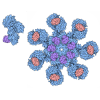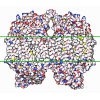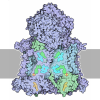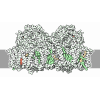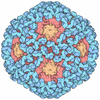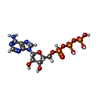+ データを開く
データを開く
- 基本情報
基本情報
| 登録情報 | データベース: PDB / ID: 3j2t | |||||||||
|---|---|---|---|---|---|---|---|---|---|---|
| タイトル | An improved model of the human apoptosome | |||||||||
 要素 要素 |
| |||||||||
 キーワード キーワード | APOPTOSIS / Apoptosis protease activating factor-1 / Apaf-1 / cytochrome c | |||||||||
| 機能・相同性 |  機能・相同性情報 機能・相同性情報Release of apoptotic factors from the mitochondria / Formation of apoptosome / Activation of caspases through apoptosome-mediated cleavage / Pyroptosis / Regulation of the apoptosome activity / Transcriptional activation of mitochondrial biogenesis / response to G1 DNA damage checkpoint signaling / regulation of apoptotic DNA fragmentation / Formation of apoptosome / Detoxification of Reactive Oxygen Species ...Release of apoptotic factors from the mitochondria / Formation of apoptosome / Activation of caspases through apoptosome-mediated cleavage / Pyroptosis / Regulation of the apoptosome activity / Transcriptional activation of mitochondrial biogenesis / response to G1 DNA damage checkpoint signaling / regulation of apoptotic DNA fragmentation / Formation of apoptosome / Detoxification of Reactive Oxygen Species / apoptosome / TP53 Regulates Metabolic Genes / Cytoprotection by HMOX1 / cysteine-type endopeptidase activator activity / Respiratory electron transport / Activation of caspases through apoptosome-mediated cleavage / Regulation of the apoptosome activity / SMAC (DIABLO) binds to IAPs / SMAC(DIABLO)-mediated dissociation of IAP:caspase complexes / mitochondrial electron transport, cytochrome c to oxygen / cysteine-type endopeptidase activator activity involved in apoptotic process / mitochondrial electron transport, ubiquinol to cytochrome c / TP53 Regulates Transcription of Caspase Activators and Caspases / Transcriptional Regulation by E2F6 / forebrain development / intrinsic apoptotic signaling pathway in response to endoplasmic reticulum stress / cellular response to transforming growth factor beta stimulus / heat shock protein binding / cardiac muscle cell apoptotic process / response to nutrient / intrinsic apoptotic signaling pathway / positive regulation of apoptotic signaling pathway / neural tube closure / kidney development / ADP binding / mitochondrial intermembrane space / nervous system development / neuron apoptotic process / secretory granule lumen / regulation of apoptotic process / ficolin-1-rich granule lumen / cell differentiation / response to hypoxia / electron transfer activity / positive regulation of apoptotic process / nucleotide binding / apoptotic process / heme binding / Neutrophil degranulation / protein-containing complex / extracellular exosome / extracellular region / ATP binding / metal ion binding / identical protein binding / nucleus / cytosol 類似検索 - 分子機能 | |||||||||
| 生物種 |  Homo sapiens (ヒト) Homo sapiens (ヒト) | |||||||||
| 手法 | 電子顕微鏡法 / 単粒子再構成法 / クライオ電子顕微鏡法 / 解像度: 9.5 Å | |||||||||
 データ登録者 データ登録者 | Yuan, S. / Topf, M. / Akey, C.W. | |||||||||
 引用 引用 |  ジャーナル: Biochemistry / 年: 2013 ジャーナル: Biochemistry / 年: 2013タイトル: Changes in Apaf-1 conformation that drive apoptosome assembly. 著者: Shujun Yuan / Maya Topf / Thomas F Reubold / Susanne Eschenburg / Christopher W Akey /  要旨: Apoptosome assembly is highly regulated in the intrinsic cell death pathway. To better understand this step, we created an improved model of the human apoptosome using a crystal structure of full ...Apoptosome assembly is highly regulated in the intrinsic cell death pathway. To better understand this step, we created an improved model of the human apoptosome using a crystal structure of full length Apaf-1 and a single particle, electron density map at ~9.5 Å resolution. The apoptosome model includes N-terminal domains of Apaf-1, cognate β-propellers, and cytochrome c. A direct comparison of Apaf-1 in the apoptosome and as a monomer reveals conformational changes that occur during the first two steps of assembly. This includes an induced-fit mechanism for cytochrome c binding to regulatory β-propellers, which is dependent on shape and charge complementarity, and a large rotation of the nucleotide binding module during nucleotide exchange. These linked conformational changes create an extended Apaf-1 monomer and drive apoptosome assembly. Moreover, the N-terminal CARD in the inactive Apaf-1 monomer is not shielded from other proteins by β-propellers. Hence, the Apaf-1 CARD may be free to interact with a procaspase-9 CARD either before or during apoptosome assembly. Irrespective of the timing, the end product of assembly is a holo-apoptosome with an acentric CARD-CARD disk and tethered pc-9 catalytic domains. Subsequent activation of pc-9 leads to a proteolytic cascade and cell death. #1:  ジャーナル: Structure / 年: 2010 ジャーナル: Structure / 年: 2010タイトル: Structure of an apoptosome-procaspase-9 CARD complex. 著者: Shujun Yuan / Xinchao Yu / Maya Topf / Steven J Ludtke / Xiaodong Wang / Christopher W Akey /  要旨: Apaf-1 coassembles with cytochrome c to form the apoptosome, which then binds and activates procaspase-9 (pc-9). We removed pc-9 catalytic domains from the holoapoptosome by site-directed ...Apaf-1 coassembles with cytochrome c to form the apoptosome, which then binds and activates procaspase-9 (pc-9). We removed pc-9 catalytic domains from the holoapoptosome by site-directed thrombinolysis. A structure of the resulting apoptosome-pc-9 CARD complex was then determined at approximately 9.5 A resolution. In our model, the central hub is constructed like other AAA+ protein rings but also contains novel features. At higher radius, the regulatory region of each Apaf-1 is comprised of tandem seven and eight blade beta-propellers with cytochrome c docked between them. Remarkably, Apaf-1 CARDs are disordered in the ground state. During activation, each Apaf-1 CARD interacts with a pc-9 CARD and these heterodimers form a flexibly tethered "disk" that sits above the central hub. When taken together, the data reveal conformational changes during Apaf-1 assembly that allow pc-9 activation. The model also provides a plausible explanation for the effects of NOD mutations that have been mapped onto the central hub. | |||||||||
| 履歴 |
|
- 構造の表示
構造の表示
| ムービー |
 ムービービューア ムービービューア |
|---|---|
| 構造ビューア | 分子:  Molmil Molmil Jmol/JSmol Jmol/JSmol |
- ダウンロードとリンク
ダウンロードとリンク
- ダウンロード
ダウンロード
| PDBx/mmCIF形式 |  3j2t.cif.gz 3j2t.cif.gz | 1.5 MB | 表示 |  PDBx/mmCIF形式 PDBx/mmCIF形式 |
|---|---|---|---|---|
| PDB形式 |  pdb3j2t.ent.gz pdb3j2t.ent.gz | 1.2 MB | 表示 |  PDB形式 PDB形式 |
| PDBx/mmJSON形式 |  3j2t.json.gz 3j2t.json.gz | ツリー表示 |  PDBx/mmJSON形式 PDBx/mmJSON形式 | |
| その他 |  その他のダウンロード その他のダウンロード |
-検証レポート
| アーカイブディレクトリ |  https://data.pdbj.org/pub/pdb/validation_reports/j2/3j2t https://data.pdbj.org/pub/pdb/validation_reports/j2/3j2t ftp://data.pdbj.org/pub/pdb/validation_reports/j2/3j2t ftp://data.pdbj.org/pub/pdb/validation_reports/j2/3j2t | HTTPS FTP |
|---|
-関連構造データ
- リンク
リンク
- 集合体
集合体
| 登録構造単位 | 
|
|---|---|
| 1 |
|
- 要素
要素
| #1: タンパク質 | 分子量: 144095.812 Da / 分子数: 7 / 由来タイプ: 組換発現 / 由来: (組換発現)  Homo sapiens (ヒト) / 遺伝子: Apaf-1, APAF1, KIAA0413 / プラスミド: pFastBac1 Homo sapiens (ヒト) / 遺伝子: Apaf-1, APAF1, KIAA0413 / プラスミド: pFastBac1発現宿主:  株 (発現宿主): sf21 / 参照: UniProt: O14727 #2: タンパク質 | 分子量: 11595.392 Da / 分子数: 7 / 由来タイプ: 天然 / 由来: (天然)  #3: 化合物 | ChemComp-ATP / #4: 化合物 | ChemComp-HEM / Has protein modification | Y | |
|---|
-実験情報
-実験
| 実験 | 手法: 電子顕微鏡法 |
|---|---|
| EM実験 | 試料の集合状態: PARTICLE / 3次元再構成法: 単粒子再構成法 |
- 試料調製
試料調製
| 構成要素 |
| |||||||||||||||
|---|---|---|---|---|---|---|---|---|---|---|---|---|---|---|---|---|
| 緩衝液 | 名称: low salt HEPES buffer / pH: 7.5 詳細: 20mM HEPES, 10mM KCl, 1.5mM MgCl2, 1mM EDTA, 1mM EGTA, 1mM DTT | |||||||||||||||
| 試料 | 濃度: 3 mg/ml / 包埋: NO / シャドウイング: NO / 染色: NO / 凍結: YES | |||||||||||||||
| 試料支持 | 詳細: Quantifoil R1.2/1.3 holey grid | |||||||||||||||
| 急速凍結 | 装置: FEI VITROBOT MARK III / 凍結剤: ETHANE / Temp: 77 K / 湿度: 100 % 詳細: Blot for 2 seconds before plunging (FEI VITROBOT MARK III) 手法: Blot for 2 seconds before plunging |
- 電子顕微鏡撮影
電子顕微鏡撮影
| 実験機器 | 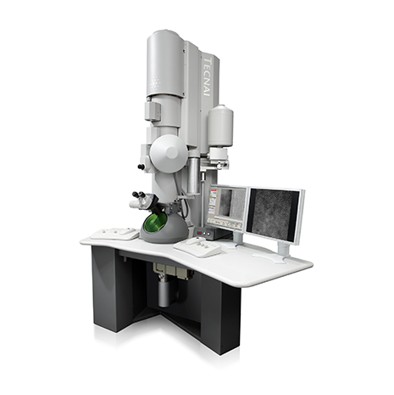 モデル: Tecnai F20 / 画像提供: FEI Company |
|---|---|
| 顕微鏡 | モデル: FEI TECNAI F20 / 日付: 2008年8月1日 |
| 電子銃 | 電子線源:  FIELD EMISSION GUN / 加速電圧: 120 kV / 照射モード: FLOOD BEAM FIELD EMISSION GUN / 加速電圧: 120 kV / 照射モード: FLOOD BEAM |
| 電子レンズ | モード: BRIGHT FIELD / 倍率(公称値): 62000 X / 倍率(補正後): 62000 X / 最大 デフォーカス(公称値): 3000 nm / 最小 デフォーカス(公称値): 1500 nm / Cs: 2 mm |
| 試料ホルダ | 試料ホルダーモデル: GATAN LIQUID NITROGEN 資料ホルダタイプ: Side entry liquid nitrogen-cooled cryo specimen holder 温度: 96 K / 傾斜角・最大: 0 ° / 傾斜角・最小: 0 ° |
| 撮影 | 電子線照射量: 25 e/Å2 / フィルム・検出器のモデル: KODAK SO-163 FILM |
| 画像スキャン | デジタル画像の数: 400 |
| 放射 | プロトコル: SINGLE WAVELENGTH / 単色(M)・ラウエ(L): M / 散乱光タイプ: x-ray |
| 放射波長 | 相対比: 1 |
- 解析
解析
| EMソフトウェア |
| ||||||||||||||||||||||||||||
|---|---|---|---|---|---|---|---|---|---|---|---|---|---|---|---|---|---|---|---|---|---|---|---|---|---|---|---|---|---|
| CTF補正 | 詳細: CTF correction was done on each particle image based on summed power spectra from each micrograph. | ||||||||||||||||||||||||||||
| 対称性 | 点対称性: C7 (7回回転対称) | ||||||||||||||||||||||||||||
| 3次元再構成 | 手法: Projection Matching / 解像度: 9.5 Å / 粒子像の数: 34000 / ピクセルサイズ(公称値): 2.26 Å / ピクセルサイズ(実測値): 2.26 Å / 倍率補正: TMV images / 詳細: EMAN was used for reconstruction using C7 symmetry. / 対称性のタイプ: POINT | ||||||||||||||||||||||||||||
| 原子モデル構築 |
| ||||||||||||||||||||||||||||
| 原子モデル構築 |
| ||||||||||||||||||||||||||||
| 精密化ステップ | サイクル: LAST
|
 ムービー
ムービー コントローラー
コントローラー








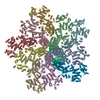
 PDBj
PDBj